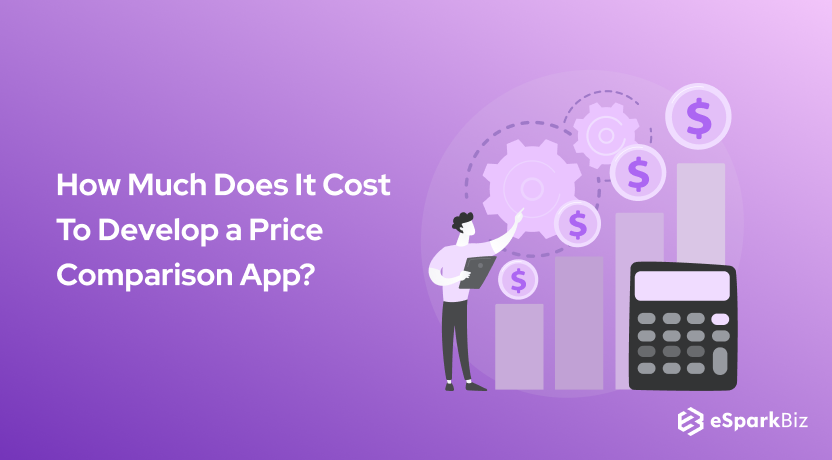“Price comparison apps and websites are the quintessence of the online retail industry.”
Cost To Develop A Price Comparison App
It is true that earlier people didn’t even think about how big of a hole their shopping expense is going to drill in their pocket. But the time has changed, and shoppers have become smart.
With so many brands and companies producing the same products, it becomes tough for a shopper to decide. And none of them wants to be wrong about what they buy.
So, what do they do?
With so many substitutes available in the market, all that a shopper needs to do is ‘compare.’
Since mobile apps have covered all industrial niche, they are more than ready to simplify the complex concept of price comparison.
What Is a Price Comparison Mobile Application?
A price comparison mobile application or web application allows its users to compare prices of one or similar products from many sellers/retailers. Some of the apps have a barcode scanner, while in other apps, the users have to enter the product name to find and compare the prices of the product.
All those shoppers who want to save money on their purchases must use a price comparison app.
What Is The Concept Behind The Price Comparison App?
The concept of the price comparison app is straightforward. The user will enter the name of a product, and the app will enlist the product or similar product for which the user is looking for with its price on different platforms.
For instance, a shopper is searching for an Adata’s Hard Disk. The user will have to enter the product name, and the app will gather and display the price of the Adata’s Hard Disk or other hard disks from Amazon, Alibaba, Walmart, and other online stores on a single screen.
Isn’t it cool? ?
Many businesses are looking forward to developing their price comparison apps. If you are one of them, then you should read further to find out everything you should know before you Hire A Mobile App Developer from eSparkBiz, a reputed firm for developing apps.
A Few Facts About Price Comparison
- As far as online shopping goes, 81% of shoppers do online research before buying a product.
- Market Track’s studies show that 80% of customers do online research even before purchasing a physical location.
- On average, customers visit at least three different websites before making a purchasing decision.
- E-tailing group’s study shows that customers believe in researching products before buying it, to find out the best price. It means a customer Google the costs of a product they want to buy.
These facts show how a price comparison app can make its way into the shopper’s life and the potential of developing such an app.
Some Of The Most Famous Price Comparison Apps
ShopSavvy
ShopSavvy allows users to scan barcodes in stores. After examining the barcode, users will see the price of the product from both physical and online stores. Along with price comparison, the app features product reviews, and help its users to find the best deals.
In ShopSavvy, users can also set up notifications for particular products, categories, or searches to get instantly notified if there is any sale in that specific product, or if that product is back in stock, or if it’s available in the physical stores again.
Being one of the most popular price comparison apps, ShopSavvy has more than 100 million downloads, and the app receives more than 50 million products per month.
BuyVia
BuyVia shows the best prices from online stores or an app like Walmart, Amazon, Target, and more. Users can scan barcodes as well as QR codes. The app also has a filter to show relevant offers and products only.
It also notifies the users if there is any sale on the categories of products that the user has selected while setting up the app. Users can also create price drop alerts on the app for any specific item.
BuyVia’s result page is not as good as other apps, but it usually displays the user’s options that other apps might not.
ScanLife
Like many apps, ScanLife also has a barcode scanner. The app gives an opportunity to shop owners to reward their customers for their loyalty. The main screen of the app is a barcode scanner which makes the app user-friendly and allows the user to scan the product’s barcode right away.
PricePirates
PricePirates is another price comparison app that displays the best prices for the products available on Amazon, Shopping.com, and eBay. Users need to enter the product’s name in the search bar, and one can see a list of similar products on the result page.
PricePirates does not feature any barcode or QR Scanner within the app.
Core Features Of The Price Comparison App
Push Notifications
An On-Demand Price Comparison App integrated with push notification plays a significant role in updating the users about the latest deals and offers available on the app. Push notification about user’s favorite products will help you keep your users attuned with your app.
Video And Graphics Descriptions
It is a must-have feature for all price comparison app. Products and services should be showcased through infographics and promotional videos. It helps in attracting the customer’s attention and obtaining maximum orders.
For a fact, short app promo online videos or graphical representation of the products encourages the users to buy it.
Reviews And Ratings
Publishing accurate information for users is very crucial for a price comparison app. Customer’s reviews & ratings help in making the app trustworthy and to acquire a vast user base.
Communication
In-app communication makes the user feel like their opinion is important.
Users must be able to communicate with the admin for any query. With in-app communication, users can talk to the representatives directly about the quality of the service. Users can also inform about the areas and factors that need improvement. It is essential to improve the retention rate and customer experience to keep them attuned with your app.
Trending
Everyone wants to keep up with the latest trend. So, it becomes imperative that your price comparison app show the users the products that are trending based on their previous searches.
Integrating Social Media
Today’s tech-savvy generation loves this feature. They like to share the product that they have bought, on social media. Incorporating social media within the app will boost the overall shopping experience of the user.
Users can also share their wish list with their friends. The integration of social media within the app is also beneficial for the app owner as the app gets free publicity when any user shares his/her wish list or their newly bought products on social media.
Scan and Compare
Your app must have the latest technologies integrated into it to compete with other apps. In-built barcode scanner and QR scanner is a must. With the scanners, users can scan the code and find the best price for the product on both physical and online stores. It also enhances the shopping experience by saving time.
Blog
To keep the users engaged with your app, it becomes entirely necessary to continue publishing information about price updates, offers & deals, news, etc. It is another way of promoting products and services.
Get Seller’s Details
With this feature, the users can know the seller’s details like their contact details, address, specializations, etc. Sometimes, users may receive a damaged or faulty product; at that moment, having all the information might come in handy.
Technology Stack
To develop the best in class price comparison app, you must select the best technological stack. An app that adheres to all the quality standards and is optimized to give its best performance will always be ahead of its competition.
UI/UX Design
For the Android platform, Java or Kotlin will do the work, and for the iOS framework development, Swift is the best option.
Cloud Servers
In case you have to store a massive amount of data, then you may consider Google Cloud Storage or Amazon Data Servers to maintain all the users dealers, and all product-related data securely.
Analytics
Integrating a stable analytic API will give you detailed information of the KPIs like orders, sales, retailers associated, etc. to help you make decisions in real-time.
Text And Phone Verification
To avoid spam bots and have authentic users, text and phone verification step is a must. The app developers must use Google Sign-in or Facebook SDK.
Database
To handle consumer’s data in an organized manner, the app developers can use MongoDB, Cassandra, MySQL, HBase, Postgress, etc.
Types Of Panels
The app has three panel-
- Admin Panel
- User Panel
- Retailer Panel
Features Of The Admin Panel
Dashboard
Admin can monitor all orders and their status. He/she can also analyze the cost structure and all the related details.
User Management
Admin tracks all the users registered on the app.
Product Management
Admin enlists and manages all the products showcased on the app and their price on an eCommerce product page of websites.
Service Management
Admin tracks all the services provided by the app like product listing, shipping services, offers, notification, rate standards, etc.
Notification Panel
Admin manages all the information related to payment, order confirmation, deliveries, etc.
Generate Reports
The admin tracks and manages all the reports generated for the products purchased, running price standard, etc.
Manage Earnings
The admin manages all the revenue generated by the subscription packages, in-app purchases, and orders placed.
Features Of The User Panel
Log in/Sing Up
The users will have to register on the app. They can do so either by using their email account credentials or social media websites like Facebook.
Social Media
Users can showcase their purchases that they have made through the price comparison app and they can also share their shopping experience.
Account Verification
Account verification is vital to avoid spambots. Post-registration, users will receive a verification code either in their email ID or registered phone number to verify themselves.
Browse Products
Users can scroll through different categories, browse products, see and compare their prices from different eCommerce portals.
View Product Listing
Users can create a product list. The list enables the users to keep a check on the changing price of the products and also helps them to analyze the product more conveniently.
Get Product Details
Users can find information about their products. After comparing the specifications, and prices the user can make a cost-effective decision.
Save Products
Users can save products as well. They may review the product whenever they want to.
Select The Desired Product
Users can select the desired product and order them later at the displayed price.
Order History
The users can review all the orders they have placed before at any given time in the order history along with other information like specifications, billing details, invoices, etc.
Features of the Retailer Panel
Product Submission
Retailers upload the product list. Then the list is reviewed by the admin, after discussing it the admin approves the product list.
It is the step where the retailer selects a submission format to upload the product list. Mostly the product list is uploaded in a CSV format, which outlines the various products. Then the list is sent to the admin.
Edits & Upload
As required, the retailers can edit the product’s list or description any time they want, even when the product is live on the app.
Order Tracking
Retailers can track all the orders generated for his/her product. He/she can also make provisions for the delivery.
Read also: A Guide On Choosing The Right Mobile App Database
App Platforms
Developing the app for all or multiple platforms will increase the rate of your price comparison app.
The price increases because the programming language for each platform is different. iOS platform uses Objective-C or Xcode IDE or Swift Programming language, Windows uses C# programming language, and the Android platform uses Java programming language.
So, if you want to develop the app for all the platforms, then the developer will have to use native programming language for each platform, thus increasing the cost of development.
Customizations
More customization will require more time to develop the app. These customizations may include animations, screens, interaction elements, navigation, etc.
As these customizations will make the app more engaging, it will increase the overall cost of development as well.
Number of Screens
The number of screens is directly proportional to the cost of development. The more displays you will include, the more time it will take to build the app. Increasing the work hour as well as the app’s development cost.
Complexity
Building your app with many complex navigational elements will further increase the development cost.
It is highly recommended to use simple navigation within the app as it provides the users with the best user experience and reduces the development cost as well.
Integrating Third Party APIs
Developers will need time to learn the third-party APIs to make the app communicate with other third-party services.
Offline Support
Developing offline support for the app can be time-consuming, which no doubt will increase the cost of development.
Handoff Feature
Handoff feature is a feature that allows the information and data to move between different devices. To integrate the handoff feature within the app will require a lot of time, which will result in the increased development cost.
The Talent Required To Build a Quality Price Comparison Mobile App
Building a high-quality price comparison app will require many talents with different specialties:
Wireframing
An experienced UX specialist is needed to design the app screen for delivering the best user experience.
App Screen Designing
A designer should know about designing screens for different devices and must be well aware of using the right graphics, size, icons, and themes for the app.
Programming
Usually, a programmer is either experienced in iOS app development or Android app development. But if you want to develop your app for all the platforms, then the programmer must be experienced in using all programming languages like Objective-C, Swift, Xcode, Java.
Back-end and APIs
The programmer must have years of experience in writing maintainable codes, performance, and security.
Quality Assurance
Experienced and detail-oriented Quality Assurance Specialist and Tester is needed to check for all functionality and design glitches.
To build a sophisticated price comparison mobile app which is well designed, functional, user-friendly and scalable, you will need experienced Developers, Programmers, Designers, Testers, etc.
How To Develop a Sophisticated Price Comparison App?
To become successful in the price comparison niche and hyper-competitive market, you will have to develop a superior-quality price comparison mobile app.
To get a polished price comparison app developed, you might need to consider? the following things:
Know What Your User’s Requirement Is
It is a very crucial step; you need to do a lot of due diligence and research on user requirements like shopping trends, preferences, favorite websites, and many more.
Collecting all the knowledge and understanding your app user’s interest and preferences will keep you at the top of the game.
Know Your Competition
Always keep a check on your competitors or the key players in your niche. See what attributes your competitors are integrating into their price comparison mobile app to provide the best combination of services with better & innovative design.
Right Mobile App Development Company
If you want to develop a superior quality price comparison mobile app, then it is essential for you to identify the best mobile app development company.
Implementing The App Development Cycle, The Right Way
It is crucial to follow the right development procedure for building the best mobile app. The app development cycle has six stages:
- Planning
- Analysis
- Design
- Development
- Quality Assurance
- Launch
All these stages must be carried out with the right approach by the mobile app development company to develop the best price comparison mobile app.
The Estimate For Developing a Price Comparison Mobile Application
Every company usually charges on an hourly basis to develop an application. On average, it will take around 100-300 hours for developing the app for the Android platform and about 350 hours for developing the app for the iOS platform.
Developers and companies in the United States charge somewhere between $70 to $100 per hour, but any top enterprise mobile application development company gives the most reasonable rate of $20 per hour, which is a lot cheaper than any other country.
Finally, it will cost around $8000 to $20000 to develop a full-fledged price comparison mobile application.



